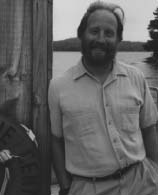

|
Vol. 4, No. 3 Contents
Headline Back Issues
Summer 2000
|
Scientist plumbs the depths:
|
||||||||||
 For more than 15 years, Dr. Robert Steneck has scuba dived and used submarines and video cameras to study lobster habitat in the Gulf of Maine and other parts of the globe. A University of Maine marine ecologist at the Marine Darling Center in Walpole, his research has earned him a Pew Fellowship in Marine Conservation in 1998 and many other honors. As someone who spends a lot of time investigating the underworld of the Gulf of Maine, Steneck was asked to give readers a close-up of what he has found, and share some of his thoughts on protecting the marine environment. Here is an excerpt from that conversation: For more than 15 years, Dr. Robert Steneck has scuba dived and used submarines and video cameras to study lobster habitat in the Gulf of Maine and other parts of the globe. A University of Maine marine ecologist at the Marine Darling Center in Walpole, his research has earned him a Pew Fellowship in Marine Conservation in 1998 and many other honors. As someone who spends a lot of time investigating the underworld of the Gulf of Maine, Steneck was asked to give readers a close-up of what he has found, and share some of his thoughts on protecting the marine environment. Here is an excerpt from that conversation:
From what you have seen as an undersea scientist, is it necessary to have more marine protected areas, and if so, why? I think the biggest value of MPAs is to preserve biodiversity so we can get a better idea of what an undisturbed segment of a marine ecosystem looks like. What strikes me when I view the sea floor from a submarine or with a remotely operated vehicle is the general lack of vertical structure. Slow growing erect invertebrates sometimes are only found nestled next to a huge boulder that has deflected trawls and thus is a micro-refuge from dragging. I often see trawl door marks on the bottom. The frequency of dragging is so great in some areas that my experiments don't stay in place for even 24 hours. Once, more than a decade ago, I placed an experiment package on the bottom with an acoustic pinger. The next morning we were in the sub trying to follow the pinger signal but it seemed to be coming from the wrong direction. We followed the signal anyway but soon realized it was moving faster than we were - it was inside a dragger's net. No critter could possibly persist in an environment with drag frequencies less than a day.
How does this affect the marine food chain? Besides changes to the ocean floor, marine food webs are radically different from their ancestral state. One of the biggest changes is the virtual loss of large predatory finfish from the Gulf of Maine ecosystem. I'm not saying they are absent but that their impact is low because they persist at such low densities. My research indicates that the invertebrates that dominate the ecology and fisheries of the Gulf of Maine, are all potential food for large and historically abundant ground fish. What are the advantages or disadvantages of single species management? Single species management overlooks interactions. However, if you look at the top 10 most valuable species to Maine's fisheries, you will see almost none of them interact with each other. That's a very unpopular thing to say. There is a notion, especially among some environmentalists, that each and every species is integral to the structure and function of marine ecosystems. If it's generally correct that 80 percent of a lobster's diet is lobster trap bait, then they are non-interacters where they are well fed. I doubt we'd see compensatory change in many [or] any organisms if lobster abundance went way up or way down. Urchins interact with kelp and seaweed but little else. Northern shrimp, sea scallops, mussels, soft-shelled clams, etc., are all valuable species but they don't seem to control other species in the system. Top predators such as big cod or haddock, in contrast, probably had a major controlling influence on invertebrates and other fish but they are functionally out of the ecosystem. When you consider where the essential habitats are for commercially valuable species you realize that different species require different habitats. Offshore gravel for cod, inshore cobble for lobsters, algae free zones for urchins. As heretical as it may sound, it might make more sense to focus on single species for some aspects of fisheries management. What about protecting biodiversity? Having said the above, there should also be room in our oceans to preserve biodiversity without strings to fisheries management. I'd like to see fishers, scientists and managers discuss how we can best manage our oceans. It's clear that fishing activities are formally or informally zoned. It might be a good idea to consider developing a comprehensive plan - one that limits some or all fishing in some areas but allows higher levels elsewhere. Careful attention to how we fish, where we fish, when we fish and how efficiently we fish is likely to be an improvement over our current fisheries management. But I don't think any of these new ideas are likely to go anywhere without involving the fishing community. Personally, I see our current interest in marine protected areas in the Gulf of Maine as a great opportunity to discuss the topic, see where there is consensus and move rapidly in those directions. |
|||||||||||